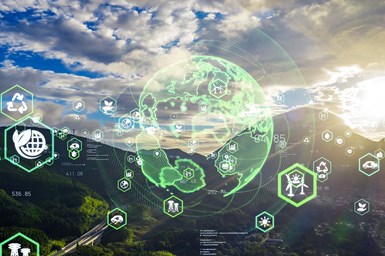EOS Develops Sustainable Polymers for Additive Manufacturing
The climate-neutral PA 1101 and carbon-reduced PA 2200 polymer materials are designed to increase production efficiency, while supporting more sustainable additive manufacturing.
EOS developed its climate-neutral PA 1101 and carbon-reduced PA 2200 polymer materials for 3D printing as part of its efforts to create more sustainable materials, systems and processes for additive manufacturing (AM). When it comes to AM materials, EOS looks at three dimensions — material sourcing, material consumption during the 3D printing process and material reusability for continuous part production and the reduction of powder waste.
The PA 1101 climate-neutral polymer material is a bio-based material that provides a smaller carbon footprint than petrol-based polymers. Production efficiency has been and will be continuously improved for this material, according to the company.
The term climate-neutral reflects the broader inclusiveness of other greenhouse gases in climate change, even if carbon dioxide is the most abundant. The material comes with proven quality and material composition, yet now it is climate neutral to support customer’s own climate protection and sustainability goals. Customers will receive a certificate that proves the correct calculation and offsetting for the application.
EOS’ PA 2200 carbon-reduced polymer material has a notable set of properties for final part properties. The material is traditionally a petrol-based polymer, with an elevated impact on climate. EOS aims to constantly increase production efficiency of this material while providing the added value of almost 45% reduced CO2e footprint of the PA 2200 carbon-reduced. For material production, renewable energies are used.
For material sourcing, EOS focuses on three factors — the choice of polymers for 3D printing, how the polymer powders are being generated and how the qualified AM powder is being processed on EOS systems. Depending on the choice of raw materials, the CO2e footprint for AM powder production can be reduced by increased production efficiency and quality to lower scrap and increase material reusability throughout the production journey.
“When it comes to responsible manufacturing, we currently evaluate the climate impact of every aspect of industrial 3D printing to create transparency of the status quo. We also evaluate and improve production efficiency. For our new environmentally green materials, we reduce greenhouse gas emissions as much as possible,” says Björn Hannappel, head of EOS sustainability bei EOS. “And we invest in Gold Standard climate protection projects to offset the unavoidable greenhouse gas emissions. Sustainability is not just a key driver for us but has also become increasingly important to our customers as well.”
- Check out this episode of The Cool Parts Show to learn how EOS helped to create shoe insoles precisely tailored to individual feet. Scanning feet for their geometry and pressure enables Aetrex and EOS to manufacture insoles that are unique to individual wearers.
- Read about the EOS partnership with Hyperganic to elevate space components. Integration of Hyperganic Core, an AI-powered engineering software platform, with EOS’ digital additive manufacturing solutions aims to advance the space propulsion field.
- Learn about the EOS partnership with PostProcess for automated depowdering. The collaboration aims to enable more sustainable automation through the additive manufacturing workflow.
Related Content
-
DMG MORI: Build Plate “Pucks” Cut Postprocessing Time by 80%
For spinal implants and other small 3D printed parts made through laser powder bed fusion, separate clampable units resting within the build plate provide for easy transfer to a CNC lathe.
-
At General Atomics, Do Unmanned Aerial Systems Reveal the Future of Aircraft Manufacturing?
The maker of the Predator and SkyGuardian remote aircraft can implement additive manufacturing more rapidly and widely than the makers of other types of planes. The role of 3D printing in current and future UAS components hints at how far AM can go to save cost and time in aircraft production and design.
-
With Electrochemical Additive Manufacturing (ECAM), Cooling Technology Is Advancing by Degrees
San Diego-based Fabric8Labs is applying electroplating chemistries and DLP-style machines to 3D print cold plates for the semiconductor industry in pure copper. These complex geometries combined with the rise of liquid cooling systems promise significant improvements for thermal management.















